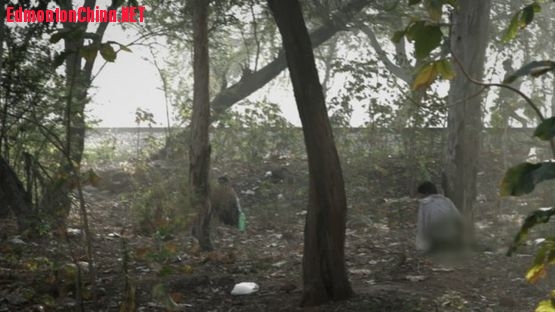 鲜花( 152)  鸡蛋( 1)
|
本帖最后由 billzhao 于 2017-11-20 16:11 编辑 ) v* t+ {7 n0 A& k- a
) F! h( l* k; r' I$ P+ a
Why do millions of Indians defecate in the open? d. B1 ]* \2 a' E
8 b/ i* m4 v6 g5 v; W* y, X
 * x0 t6 k) |1 ]5 D% |( K' O3 Q/ v( R
* x0 t6 k) |1 ]5 D% |( K' O3 Q/ v( R
7 v1 l6 p; U ?, S9 t, J
It's early morning and local commuters are queuing up for tickets at the Kirti Nagar railway station in the Indian capital, Delhi. Along the tracks, another crowd is gathering - each person on his own, separated by a modest distance. They are among the 48% of Indians who do not have access to proper sanitation.
/ b" u0 K- w7 t' ]
* ^) [/ \. i+ u' ]' \2 M, }* s1 cComing from a slum close-by, they squat among the few trees and bushes along the railway tracks and defecate in the open. To many, this is a daily morning ritual despite the hazards of contracting diseases such as diarrhoea and hepatitis.0 g, E' s) _* k% @, D0 _7 z0 W
) y# [* U8 e3 j: S1 W1 H% U
It can be even more hazardous for women since each time a woman uses the outdoors to relieve herself, she faces a danger of sexual assault. Recently two teenage girls from the state of Uttar Pradesh were gang-raped and found hanging from a tree after they left their village home to go to the toilet. Their house, like hundreds of millions of others in the country, did not have any facilities.8 p, r, }) O! R2 w7 L' V& L
5 \7 z9 v) B' j
1 ]: F8 }! E; m0 i3 qA new World Health Organisation (WHO) report says more than half a billion people in India still "continue to defecate in gutters, behind bushes or in open water bodies, with no dignity or privacy".
7 ], u7 }4 K1 v; s; i* m# O8 s6 K# E5 f- E# \/ s
+ F' C( T3 u3 {$ s. a+ v& |
Access to sanitation is a challenge that India's politicians want to tackle - both the Congress and the Bharatiya Janata Party (BJP) promised to put an end to open defecation in their 2014 general election manifestos. During his campaign, Narendra Modi, BJP's newly-elected prime minister, promised: "Toilets first, temples later". And former rural development minister Jairam Ramesh of the Congress party had stressed that "practicing good hygiene is as important as performing good puja" (act of worship in Hinduism).; I/ @% c7 t$ }( p8 G5 |$ l
' \2 a- `% h! G6 ]3 O& G5 n3 F
9 [5 D. Z! w% Z! _. {# n/ B- z3 z: o# p4 WIndia's government offers cash incentives to subsidise construction of toilets. It has also initiated hygiene and sanitation awareness campaigns, such as the "No Toilet, No Bride" slogan launched in the state of Haryana in 2005, urging brides to reject a groom if he did not have a lavatory at home.. v/ l: }1 I9 O, E- t5 I( m# Y0 T) K
The Gates Foundation too has offered grants to create latrines that are not connected to water, sewer or electricity and to improve the treatment of human waste.4 K! w; h( r+ w4 C" U
& G" Y$ H ~" y+ o# p$ @9 U
4 ?. H& U& f+ T) a5 S: DThe exhibits at a recent "toilet fair" organised by the Foundation in Delhi included a lavatory with a photovoltaic roof-top that powers a reactor breaking down excrements into fertiliser, and another one which came equipped with an automatic sterilisation system and a generator turning the moisture into water.' O' Z6 s* H$ l1 H5 a0 X
2 f( k" \, e) w2 e
Apart from poverty and lack of lavatories, one of the reasons often cited to explain open defecation in India is the ingrained cultural norm making the practice socially accepted in some parts of the society. "Just building toilets is not going to solve the problem, because open defecation is a practice acquired from the time you learn how to walk. When you grow up in an environment where everyone does it, even if later in life you have access to proper sanitation, you will revert back to it," says Sue Coates, chief of Wash (water, sanitation and hygiene) at Unicef.
- Y2 l i& F) J8 ~" W0 \) {India will be free of open defecation only when "every Indian household, every village, every part of Indian society will accept the need to use toilets and commit to do so", she says.
, @- R0 T! M- R c( B% |
0 c: |0 ^8 g& r7 t/ r8 _Professor at the Centre for Environmental Planning and Technology Meera Mehta says the strategies implemented so far may not have the expected impact because of a "lack of focus". "With the right policies and political attention, India can be free from open defecation within 10 years. |
|






